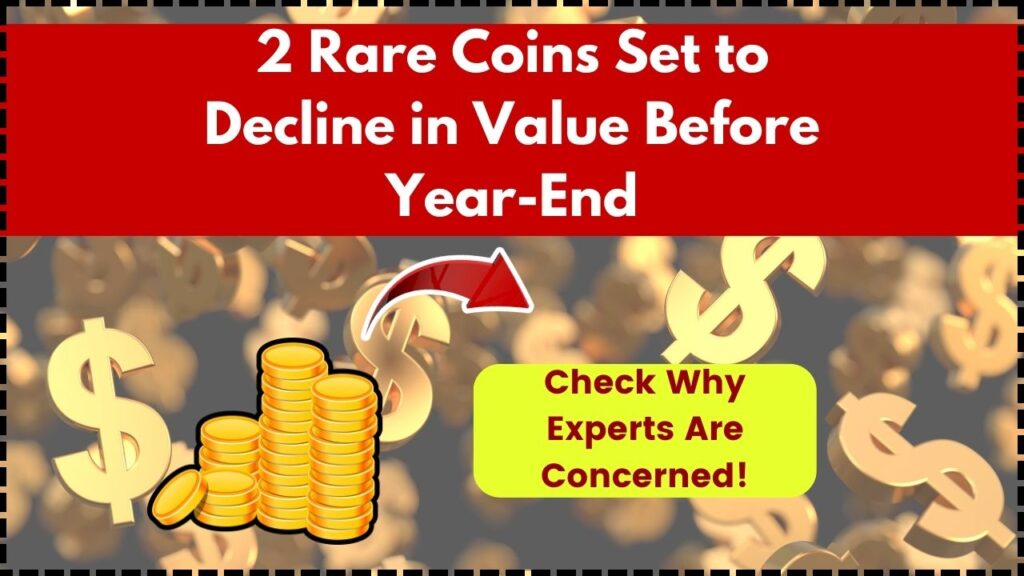
2 Rare Coins Set to Decline in Value Before Year-End: As we near the end of 2025, a surprising trend has caught the attention of coin collectors and investors across the United States. Two coins once seen as valuable assets in any collection—the 1982 Lincoln Penny (Large Date) and the 2000 $1 Silver Eagle First Strike—are projected to decline in value before the year wraps up. If you own one of these coins, don’t panic just yet. But it’s definitely time to understand what’s happening in the numismatic world, why these coins are slipping, and what smart steps you can take right now. Whether you’re a professional investor or a parent teaching your 10-year-old about money, this guide breaks it all down in clear, easy-to-follow sections.
2 Rare Coins Set to Decline in Value Before Year-End
The numismatic world is always evolving, and what was once valuable can sometimes lose its shine. If you own a 1982 Lincoln Penny (Large Date) or a 2000 $1 Silver Eagle First Strike, now is the time to reassess your collection. Values are shifting, collectors are getting smarter, and the market is moving toward authenticity, scarcity, and historical relevance. Stay informed, stay sharp, and most importantly—collect with purpose, not just popularity.
| Topic | Details |
|---|---|
| Coins Losing Value | 1982 Lincoln Penny (Large Date), 2000 $1 Silver Eagle (First Strike) |
| Estimated Value Drop | 10–25% by the end of 2025 |
| Main Causes | Overproduction, grading label disputes, collector preference changes |
| Professional Advice | Audit your collection, focus on coins with true rarity and demand |
| Official Reference | U.S. Mint, PCGS, NGC |
What’s Happening With These Coins?
1. The 1982 Lincoln Penny (Large Date)
In 1982, the U.S. Mint changed the Lincoln wheat penny’s composition from 95% copper to a cheaper zinc core with a thin copper coating. That year, both Large Date and Small Date versions were minted—some in copper, others in zinc. The Large Date zinc version was produced in huge quantities.
At first, collectors thought these would be special due to the transition. But the market is now saturated with them. In circulated condition, they’re worth little more than face value. Even in mint condition, most sell for less than a dollar.
2. The 2000 Silver Eagle “First Strike”
The Silver Eagle series is popular among investors and collectors, especially for its silver content and iconic design. But the “First Strike” label has become controversial. This designation is applied by grading companies like PCGS or NGC to coins received for grading within 30 days of release. However, there’s been criticism around how “First Strike” is defined, and whether it adds real value.
Collectors are beginning to look past this label, focusing instead on truly rare varieties or proof strikes. As demand for “First Strike” coins cools off, prices are sliding.
Why Are Experts Concerned?
Overproduction
Both the 1982 Large Date penny and the 2000 Silver Eagle were minted in huge quantities:
- Over 10 billion Lincoln cents were minted in 1982.
- The 2000 Silver Eagle had a mintage of over 9.2 million.
When coins are common, they’re simply not as valuable. It’s basic supply and demand.
Market Saturation
The numismatic market has been flooded with these coins. With eBay listings in the thousands and coin shows full of them, values drop because collectors have easy access to them.
Changing Collector Preferences
Younger collectors and modern investors are more interested in:
- Low-mintage proof coins
- Coins with certified mint errors
- Gold and silver bullion with historical significance
What used to be a must-have coin may now just be another common piece in the market.
Label Skepticism
The “First Strike” label is under fire. Although it sounds exclusive, many experts argue it’s more marketing than merit. PCGS has updated its definition multiple times, which has shaken collector confidence.
How to Authenticate 2 Rare Coins Set to Decline in Value Before Year-End?
Before making any decision, check if your coin is authentic and valuable. Here’s how:
Step 1: Weigh It
- A copper 1982 penny should weigh 3.11 grams
- A zinc 1982 penny should weigh 2.5 grams
Use a digital scale accurate to 0.01 grams.
Step 2: Visual Inspection
Use a magnifying glass to check the date size (Large vs Small Date). You can also compare your coin with verified images from the PCGS photo grading database.
Step 3: Professional Grading
Submit your coin to a reputable grader like:
- Professional Coin Grading Service (PCGS)
- Numismatic Guaranty Company (NGC)
Professional grading can confirm value and add legitimacy if you plan to sell.
Real-Life Case Study: How Values Changed Over Time
Let’s look at auction trends for the 2000 $1 Silver Eagle First Strike:
- 2010: Sold regularly for $90–$120 in MS69 condition
- 2020: Prices began to stabilize around $75–$85
- 2025: Selling between $50–$60, even in sealed slabs from top graders
That’s up to a 50% decrease over 15 years. With label skepticism increasing and many buyers focusing on lower-mintage years, this trend may continue.
What You Should Do Now?
Review Your Collection
Now’s a great time to audit what’s in your stash. Identify which coins have actual rarity versus those that were “hot” due to hype.
Consider Selling While There’s Still Demand
Even though values are declining, there’s still some demand—especially from beginner collectors. Selling now can help you recover value before prices dip further.
Reinvest Smartly
Instead of hype-based coins, consider:
- Coins with low mintages (under 100,000)
- Gold or silver coins with historical importance
- Error coins certified by PCGS or NGC
Future Outlook: What Experts Are Predicting
Top numismatic analysts expect:
- A 10–25% further decline in 1982 Large Date penny prices
- Silver Eagles to remain strong overall, but “First Strike” premiums will keep fading
Focus is shifting toward long-term, historically significant coins and those with true scarcity.
You Might Have a $19 Million Bicentennial Quarter – Check Your Pocket Before You Spend It
This Lincoln Wheat Penny Could Sell for $500,000 – Check If You’re Holding This Rare Mint
These Rare Coins Are Worth Millions – Check If Coin Collecting Is Your Next Big Investment Move
Frequently Asked Questions (FAQs)
Are these coins completely worthless now?
No. They’re still legal tender and have some collector value. But compared to rarer coins, their market value is low and declining.
Can kids still collect these coins?
Absolutely! These coins are great for beginners to learn about history, minting processes, and grading—without spending big money.
Is it bad to own these coins?
Not at all. Just know their value may not go up. Use them as learning tools or affordable gifts for young collectors.
How can I find out what my coin is worth?
Check recent sales on eBay or auction platforms.






